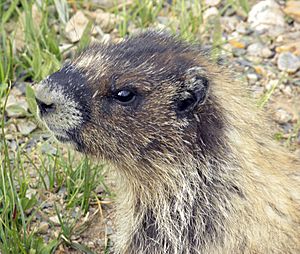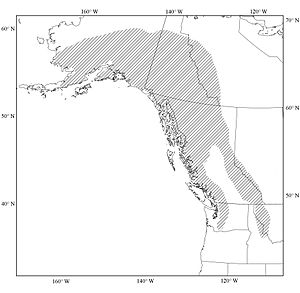Hoary marmot facts for kids
Quick facts for kids Hoary marmot |
|
|---|---|
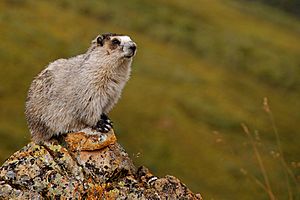 |
|
| Conservation status | |
| Scientific classification | |
| Genus: |
Marmota
|
| Species: |
caligata
|
The hoary marmot (Marmota caligata) is a type of large ground squirrel. It lives in the mountains of northwest North America. These marmots like to live near the tree line, which is where the trees stop growing. They find homes on grassy slopes with lots of plants to eat and rocky spots to hide.
It is the biggest ground squirrel in North America. People often call it "the whistler." This is because it makes a loud, high-pitched whistle. This sound warns other marmots in its group about danger. Sometimes, they are also called "whistle pigs." The town of Whistler, British Columbia, was even named after these animals! This helped make it a popular resort. The hoary marmot's closest relatives are the yellow-bellied, Olympic, and Vancouver Island marmots.
Contents
What Does a Hoary Marmot Look Like?
The hoary marmot is a big, chunky ground squirrel. It has short, strong legs and a wide head. Adult marmots are usually about 62 to 82 centimeters (24 to 32 inches) long. Their tail adds another 17 to 25 cm (7 to 10 inches) to their length.
Male hoary marmots are usually bigger than females. Their weight changes a lot during the year. This is because they hibernate for a long winter. They live off their stored fat during this time. In May, they might weigh about 3.75 kilograms (8.3 pounds). By September, they can weigh around 7 kg (15 lb). Some large males can even reach 10 kg (22 lb) in the fall! The biggest hoary marmot ever recorded weighed almost 13.5 kg (30 lb).
The word "hoary" means silver-gray. This describes the color of their fur on their shoulders and upper back. The rest of their top fur is drab or reddish-brown. Their head is black on top. They have a white patch on their nose and white fur around their mouth and chin. Their feet and lower legs are black.
Marmots have long, stiff outer hairs called guard hairs. These give them their main color. Underneath, they have soft, thick fur for warmth. Their belly is grayish and has less fur. Hoary marmots shed their fur in early to mid-summer. Their feet have slightly curved claws, which are bigger on their front feet. Their foot pads are hairless, which helps them grip rocks. The tail is long, a bit flat, and covered in thick fur.
Where Do Hoary Marmots Live?
Hoary marmots mostly live in high mountain areas, up to 2,500 meters (8,200 feet) high. But some populations near the coast in British Columbia and Alaska live close to sea level. They are found from southern Washington and central Idaho, all the way north through much of Alaska.
They live above the tree line, where trees don't grow. They prefer rocky areas or mountain meadows. These meadows are full of grasses, sedges, and other plants. Sometimes, they live near small, twisted patches of trees called Krummholz.
There are three types, or subspecies, of hoary marmots:
- Marmota caligata caligata – Found in Alaska, Yukon, Northwest Territories, and northern British Columbia.
- Marmota caligata cascandensis – Lives in the Cascade Mountains, from British Columbia to Washington.
- Marmota caligata okanagana – Found in the Rocky Mountains, from Yukon to Montana and Idaho.
Hoary Marmot Behavior and Diet
Hoary marmots are active during the day. They are also herbivores, meaning they eat plants. Their diet includes leaves, flowers, grasses, and sedges. Many animals hunt hoary marmots. These predators include golden eagles, grizzly and black bears, wolverines, coyotes, red foxes, lynxes, wolves, and cougars.
Marmots live in groups called colonies. A colony can have up to 36 marmots. Each colony usually has one main adult male. It also has up to three adult females, sometimes another male, and many young marmots.
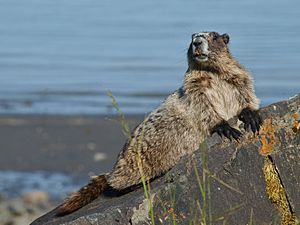

These marmots hibernate for seven to eight months each year. They sleep in burrows they dig in the ground, often under big rocks. Each colony has one main winter burrow (called a hibernaculum). They also have many smaller burrows. These smaller burrows are used for sleeping and hiding from predators. The hiding burrows are simple, just a single hole 1 to 2 meters (3 to 7 feet) deep. A colony digs about five new hiding burrows each year. An old colony might have over a hundred!
Sleeping burrows and the hibernaculum are bigger and more complex. They have several entrances and deep rooms lined with plants. They can be about 3.5 meters (11 feet) deep. A colony might have up to nine regular sleeping burrows.
Hoary marmots show many social behaviors. They play fight, wrestle, groom each other, and touch noses. These activities happen more often as winter hibernation gets closer. They don't often interact with marmots from other colonies. When they do, it's usually unfriendly, with females chasing away outsiders.
Hoary marmots are also very vocal. They have at least seven different calls. These include chirps, whistles, growls, and whining sounds. Many of these calls are alarm signals. They warn others about possible predators. They also communicate using scent. They do this by leaving droppings or by rubbing their cheeks on rocks or plants.
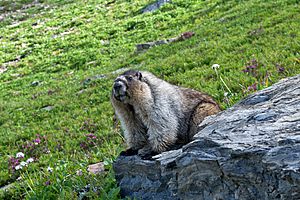
Hoary marmots often lie in the sun on rocks. They can spend almost half their morning doing this. But if it's too hot, they will go into their burrows or find shade. They spend the rest of the day looking for food. At night, they return to their burrows to sleep.
In places where people visit often, hoary marmots are not shy. Instead of running away, they often continue their activities even when watched.
Hoary Marmot Reproduction
Hoary marmots mate soon after they come out of their winter burrows in May. In some areas, like Washington State, they might even mate as early as February. Females usually have babies only every other year.
Pregnancy lasts for 25 to 30 days. So, two to five young marmots are born between late May and mid-June. The young marmots come out of their birth den when they are three to four weeks old. By then, they have a full coat of fur and are starting to eat solid food. The young are careful at first. But within about four weeks of leaving the burrow, they start acting like adult marmots. Young marmots stay with their birth colony. They usually leave when they are two years old. They become fully grown and ready to have their own babies the following year.
See also
 In Spanish: Marmota caligata para niños
In Spanish: Marmota caligata para niños



